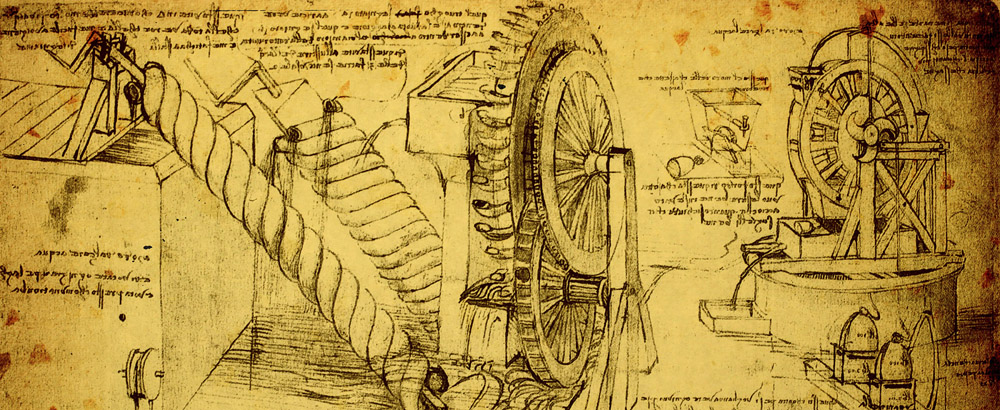What do Leonardo da Vinci, Mark Twain, Thomas Edison, Marie Curie, Thomas Jefferson and John D. Rockefeller have in common? Not all of these individuals were professional scientists, but all of them used the same simple tool of scientific inquiry to pursue their passions: a notebook.
Leonardo da Vinci’s scientific notebook is perhaps the most famous. The Renaissance artist’s “Codex Arundel” was handwritten in Italian and features mirror writing (legible only when held up to a mirror), diagrams of the human body and sketches for flying machines, catapults and other devices.i
Two hundred years later, U.S. President Thomas Jefferson kept meticulous records of weather, geography, climate and plant and animal life at his home in Virginia. It is said he carried a compass, a level and a thermometer in his pockets everywhere he went so that he could document accurately. He took notes on a set of ivory tabs connected at one end,ii very much like the resources homeschool families use today.
In the 1800s, American author Mark Twain sketched characters for his novels, but he also sketched inventions, some that he later patented. In 1883, he sketched plans for a memory-improving game that would cover 4,000 historical facts, including “Beginning and ending of Dynasties; Revolutions, Plagues, Discoveries, Introductions, Inventions, & Memorable Earthquakes, Fires, Storms, & other Calamities.”iii Imagine using that game in your history studies!
Can you picture the austere scientist Thomas Edison tearing pages out of a notebook and tossing them over his shoulder? Edison kept hundreds of softcover and hardcover notebooks during his career. In them, he wrestled with names for his experiments, in one case vacillating between “auto-electrograph,” “electrophone” and “acoustophone,” before settling on the now-famous “phonograph.”iv When he filed patents for his inventions, he had all the sketches and descriptions ready at his fingertips.
Businessman John D. Rockefeller, Sr., jotted down detailed information when he toured his oil refineries in the early 1900s, making notes for improving his business model. He started with a single, red-covered notebook he called “Ledger A.”v That first notebook reflected the accountability and diligence that would characterize his work and philanthropy throughout his career.
Nobel Prize winner Madame Curie kept detailed records from her chemical experiments, and because her notebooks were always by her side in the laboratory, they are still radioactive more than a hundred years later.vi
As they rose in their respective fields, each of these men and women kept meticulous records of their ideas and experiments, using simple notebooks to achieve great things. Today, keeping a journal of observations and ideas remains an inexpensive and invaluable tool for science students. Innovators in a wide range of disciplines have discovered the value of a simple notebook to improve the skills of memory, observation and recordkeeping. Your family, too, can benefit from adding this tool to your homeschool.
Follow these guidelines with your children to make the most of your journaling.
- Choose a notebook that is comfortable to use, easy to transport and sturdy enough to survive the rigors of science, from the kitchen sink to the backyard.
- Use a well-sharpened pencil, in case you need to erase and rewrite.
- Always start by writing your name, the date and the name of your project or experiment at the top of the page, so you can find it later.
- Be neat: Illegible handwriting may be faster, but it will slow you down later when you (or others) attempt to re-read your notes.
- When possible, use a notebook with grid lines for sketching, to capture proportions accurately.
- Leave room for marginal comments on one side of the page. Some scientists draw a vertical line to separate their results (large column) from their comments and tangential ideas (small column).
- A good principle is to record more than you think you will need. Later, you can weed out unnecessary information.
Very young children may start by sketching what they observe in their backyard: flowers, leaves, interesting bugs and unusual plants. Older children can apply these same observation skills to more complex experiments and projects. Many lab journals are designed for use in science labs, but do not be afraid to apply your skills to other field research as well, such as visiting the Grand Canyon, testing a recipe in the kitchen or going snorkeling.
Opportunities to practice science are everywhere. When your children practice good science, taking notes and recording the findings in a lab journal, they walk in the footsteps of Jefferson, Edison and Curie—but, one hopes, with a little less radiation.
Further reading:
McKay, Brett and Kate McKay. “The Pocket Notebooks of 20 Famous Men.” The Art of Manliness. September 13, 2010. http://www.artofmanliness.com/2010/09/13/the-pocket-notebooks-of-20-famo…
Footnotes
i. Notebook of Leonardo da Vinci (‘The Codex Arundel’). The British Library, Digitised Manuscripts. London: British Museum, n.d. http://www.bl.uk/manuscripts/Viewer.aspx?ref=arundel_ms_263_f001r
ii. “I Rise With the Sun” and “Drudging at the Writing Table.” Jefferson: A Day in the Life. Monticello.org. Charlottesville, VA, n.d. http://www.monticello.org/site/jefferson/i-rise-sun
iii. Mark Twain’s Notebooks & Journals, Volume III (1883–1891). Gen. Ed. Frederick Anderson. Eds. Robert Pack Browning, Michael B. Frank, and Lin Salamo. Berkeley, CA: University of California Press, 1979. 20-21.
iv. “Naming the Phonograph II” [c. 1877] The Thomas Edison Papers. Piscataway, Rutgers University, the State University of New Jersey, 2012. http://edison.rutgers.edu/docsamp.htm
v. Levenick, Christopher. “The Rockefeller Legacy.” Philanthropy. Winter 2013. http://www.philanthropyroundtable.org/topic/excellence_in_philanthropy/t…
vi. O’Carroll, Eoin. “Marie Curie: Why her papers are still radioactive.” The Christian Science Monitor. November 7, 2011. http://www.csmonitor.com/Innovation/Horizons/2011/1107/Marie-Curie-Why-h…




